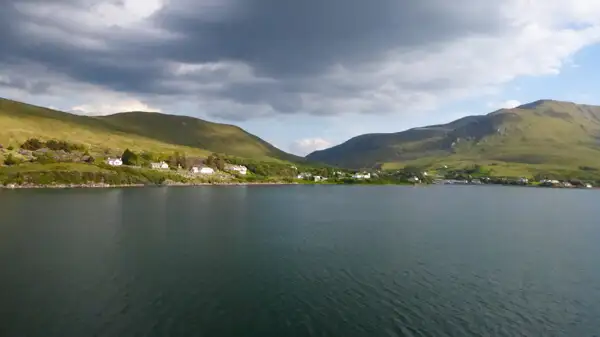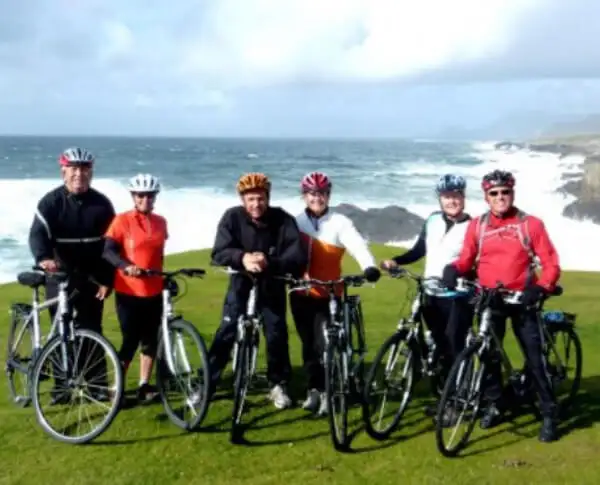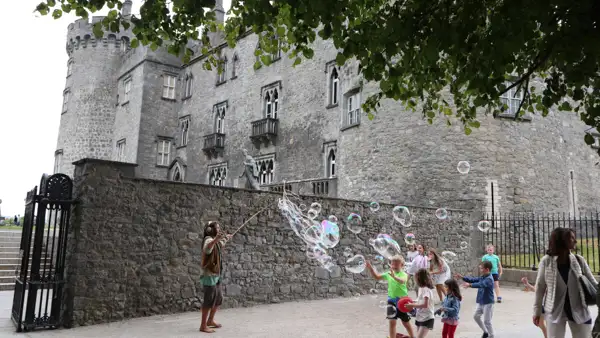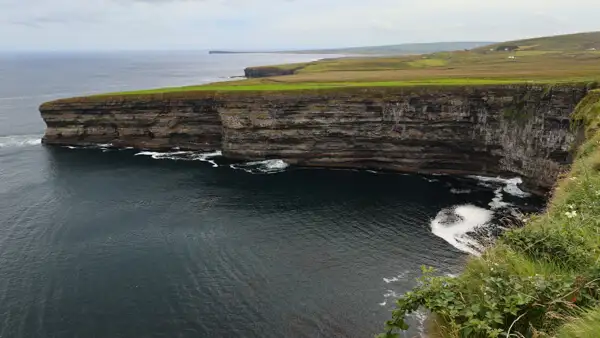Are you planning a cycling trip to Ireland and wondering what to pack? Or you still need good cycling clothes and don’t really know what to buy in the flood of offers? No problem – we can help you…
Page Contents (click line to jump the text)

The cycling weather in Ireland
Before we get to the clothes, let’s take a look at the conditions for which the clothes should be. We live in Ireland (we have our second home there) and have travelled the island a lot.
Because we have been travelling the island ourselves for years, we know the weather well in all seasons.
In the summer months you can have 25 degrees (Celsius) and sun, or 15 degrees, wind and rain. It rarely gets much hotter and then not above 30 degrees.
The rain in summer is usually less persistent than in winter, it’s more like drizzle and isolated showers that blow across the Atlantic to the island. Winds are frequent and can be quite strong on the coasts. It usually cools down well at night, even in summer. If you want to camp, don’t bring a sleeping bag that is too thin.
In spring and autumn it is usually cool, around 8-15 degrees during the day and maybe 6-10 degrees at night. Winds can be more frequent and heavy, and rain showers can be more frequent and longer lasting.
This means you should be prepared for cool and wet weather with your clothing and be flexible enough when it does get warm and dry.

The cycling shorts
Leave the jeans at home, please! Really!!!! Jeans are heavy, get wet quickly and dry with difficulty, and don’t warm when wet. Full stop. There are also better alternatives for leisure trousers after cycling, but more on that later.
I would definitely recommend a good pair of cycling shorts with a padded bottom. Your backside will thank you. These shorts are usually made of quick-drying synthetic fibres. In summer, you can ride in the drizzle without having to get out your rain pants every time.
There are loose-fitting cycling trekking trousers, or leggings-like cycling trousers. You can also combine shorts with leg warmers.
Choose what suits you best. A pair of shorts is a good idea as a second pair of trousers anyway, so one long and one short, then you are very flexible.

Jerseys and jackets
I used to wear cycling jerseys. They don’t flap in the wind, are somewhat wind-resistant but still breathable and have practical pockets in the back.
In the meantime, I also like to wear sports T-shirts, such as fitness shirts. Important here too: Synthetic fibre is usually better than cotton because it dries faster.
You can put on windbreakers or other similar jackets, but it is always important to have a bit of wind protection and a tight cut, otherwise it gets very fluttery in the wind – and there is plenty of that in Ireland.
Rainwear
This is important: “Better to have than to need!”. It’s up to you and your budget whether you choose a high-quality cycling rainwear with a breathable membrane (Gore-Tex), or a simpler model that is simply waterproof but not breathable. It is important to have a reliable waterproof rain trousers and rain jacket for when the weather gets uncomfortable.
Cycling shoes and gloves
You can ride with trainers or hiking boots. If you are going on longer tours, however, I recommend touring cycling shoes, and for Ireland they may also be waterproof.
Why? They have a stiffer sole that allows better contact and power transfer to the pedals. You tire later with them and they’re easier on your ankles.
I love to ride with clipless pedals, others prefer plateau pedals where the foot is not fixed. You can also buy pedals with a click on one side and a platform on the other, then you can also ride with different shoes.

I wore my padded short cycling gloves a lot – in warm weather the hands do sweat a bit, but the padding helps to distribute the pressure of the handlebars better. Especially on bumpy roads, of which there are many in Ireland.
Bicycle helmet and sunglasses
Do you need them? The sunglasses are essential, if only to keep dust and insects out of your eyes. I would also recommend a bicycle helmet.
Good cycle helmets are light, well ventilated and no more annoying than a cap. With their sunshade, they provide additional protection for the eyes. For the rain, there are rain covers and then the head stays mostly dry.
I always take one or more tube scarves with me (Buff or others) to keep my neck and throat warmer.
Functional underwear and socks
Good sports underwear keeps up with every movement, is easy to wash in the sink at the B&B and dries quickly. Long functional underwear helps to stay warm on cool days – and also dries quickly.
Warm layer of clothing
Fleece shirts are good to wear under your windbreaker because they keep you nice and warm. I can’t recommend them as outerwear because they are too wind-permeable.
However, there are also insulating cycling waistcoats that you can take a closer look at – you can wear them underneath or instead of the windbreaker on warmer days.
The important thing is to build up a clothing system of several layers, so that you can cover any weather from warm to cooler days by combining a few pieces of clothing – this is the onion system (many thin layers), which has proved very successful in many outdoor areas.
Other clothing and other footwear
A pair of light casual trousers, a pair of light trainers or outdoor sandals and maybe one or two shirts that aren’t cycling jerseys – and you’ll be equipped for sightseeing or going to the pub.
Wash bag, first aid and pharmacy
Keep the wash bag to a minimum, you can also buy everything locally. Small sample packs (shampoo, toothpaste) or refillable small bottles are practical.

If you need special medicines, you should bring them with you in sufficient quantity. There are many things available in Ireland, but sometimes they are different active ingredients, etc. Better safe than sorry.
A fall can happen and a small first aid kit is very helpful. Take an extra box of good adhesive plasters (extra strong) with you.
Blister plasters for your shoes can also be useful and be sure to take sunscreen! Yes, it can be sunny for longer in Ireland!
Money and ID
Ireland is part of the EU and uses the Euro, in Northern Ireland the British Pound. ATMs are not available in every town, so bring some cash with you. Major credit cards and debit cards are accepted almost everywhere.
You will need your passport to enter the country, and the usual other forms of ID are no problem either, such as a health insurance card, driving licence (rental car?) or other. Yes, I know, my flight ticket is on my smartphone – but I like to print it out again just to be on the safe side.
Electronics
And that brings us to electronics: don’t forget the charger for your smartphone and other devices you have with you, plus a powerbank. If you’re camping in the wild, a foldable solar charger can also be useful.
Summary
I hope this has helped you a bit in putting together your clothing and equipment for Ireland. The important thing to remember is:
Stay flexible with an onion system (many thin layers) for warm to cool weather.
+ Bring a good rain suit
+ Make sure your clothes fit well and are quick-drying (no cotton).
+ Don’t forget the little helpers (gloves, buff, sunglasses, cap or helmet)
+ Bring a light alternative for the time off the bike
+ Bring everything you absolutely need – and leave everything else at home.
With this in mind, I hope you have fun shopping, packing and preparing – and on your cycling trip in Ireland!
More interesting articles for you
EQUIPPING YOUR BICYCLE FOR THE BIG TRIP TO IRELAND – WHAT DO YOU NEED?
IS MY BICYCLE FIT FOR THE IRELAND TRIP? PRACTICAL TIPS FOR CHECK AND CARE
WHERE CAN YOU RENT A BICYCLE FOR A HOLIDAY TOUR IN IRLELAND?
CAN I TAKE MY OWN BICYCLE TO IRELAND? PRACTICAL TIPS
Photo credits cover photo: Painting on a house wall, photo by Ulrich Knüppel-Gertberg (www.easycruiser.tours, www.irland-insider.de, www.ireland-insider.com)